Intel Launches 144-core 'Sierra Forrest' Xeon 6 CPUs, Granite Rapids Follows in Q3
Pumping up the core counts.

Intel CEO Pat Geisinger announced the launch of the company's Xeon 6 'Sierra Forest' processors during his Computex 2024 keynote here in Taipei, Taiwan. The Xeon 6 lineup is comprised of two families. The E-core-powered Sierra Forest models with up to 144 cores are launching today, but 288-core models will follow next year. Intel's efficiency-focused 288-core chips will face off with AMD's looming density-focused 192-core EPYC Turin models when they come to market later this year.
The flagship 6900P P-core Granite Rapids models, which can have up to 128 P-cores, will launch in Q3 of 2024. Early next year, Intel will offer Granite Rapids in models with lesser core counts. These models will face off with AMD's performance-focused Turin models that will arrive later this year with up to 128 cores. Intel will also expand its Xeon 6 roster further in Q1 of 2025 with network—and edge-optimized variants.



Intel's Sierra Forest chips are the first to use the new Intel 3 process node, conferring power and performance benefits. The chips are geared for web and scale-out containerized microservices environments, networking, content delivery networks, cloud services, and AI workloads. Sierra Forrest is designed to provide the utmost performance consistency and have an extreme focus on power efficiency, accomplished with the Intel 3 process node and Crestmont microarchitecture.
The P-core-powered Granite Ridge chips are designed for latency-sensitive work and high single-core performance, making them a good fit for HPC, AI, and general workloads, among many other workloads outlined in the album above.


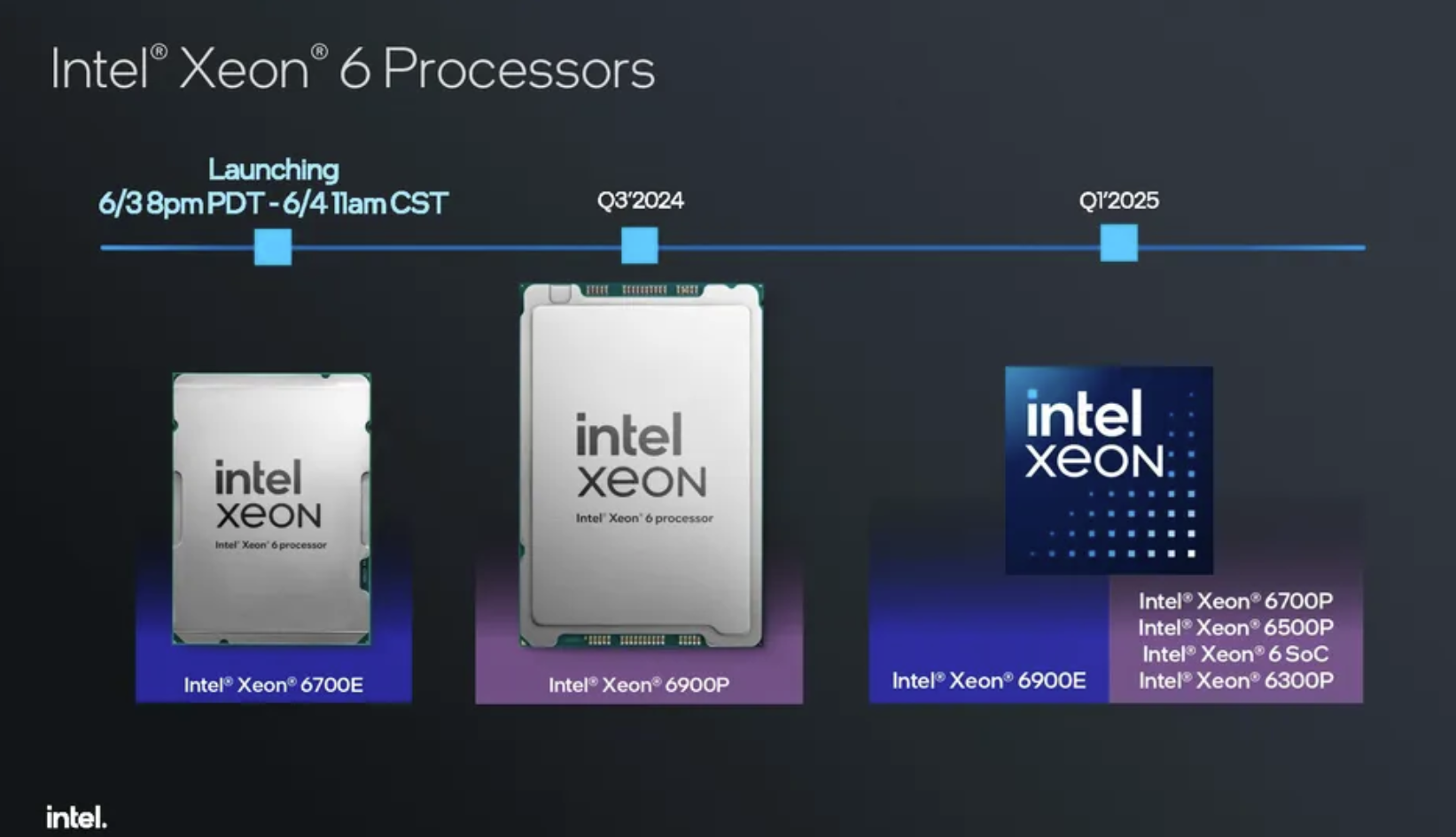

Both processors will drop into the Birch Stream platform, but Intel carves its P—and E-core offerings into two swim lanes. The Xeon 6700 series has up to either 144 E-cores or 86 P-cores and will slot into standard SP platforms that support up to 350W per CPU. Meanwhile, the 6900 series models with up to 288 E-cores or 128 P-cores will require AP platforms that support up to 500W per CPU.
The 6700E models come equipped with E-cores, as designated by the E suffix, and come in seven different models spanning from 64 cores to 144 cores. These chips have what we would typically consider to be low max turbo clocks that range from 2.6 GHz to 3.2 GHz, but this is optimum for this class of chip and helps boost performance efficiency, a key tenant of the Sierra Forest processors. Intel hasn't shared specs for the full roster of 6700P processors yet.
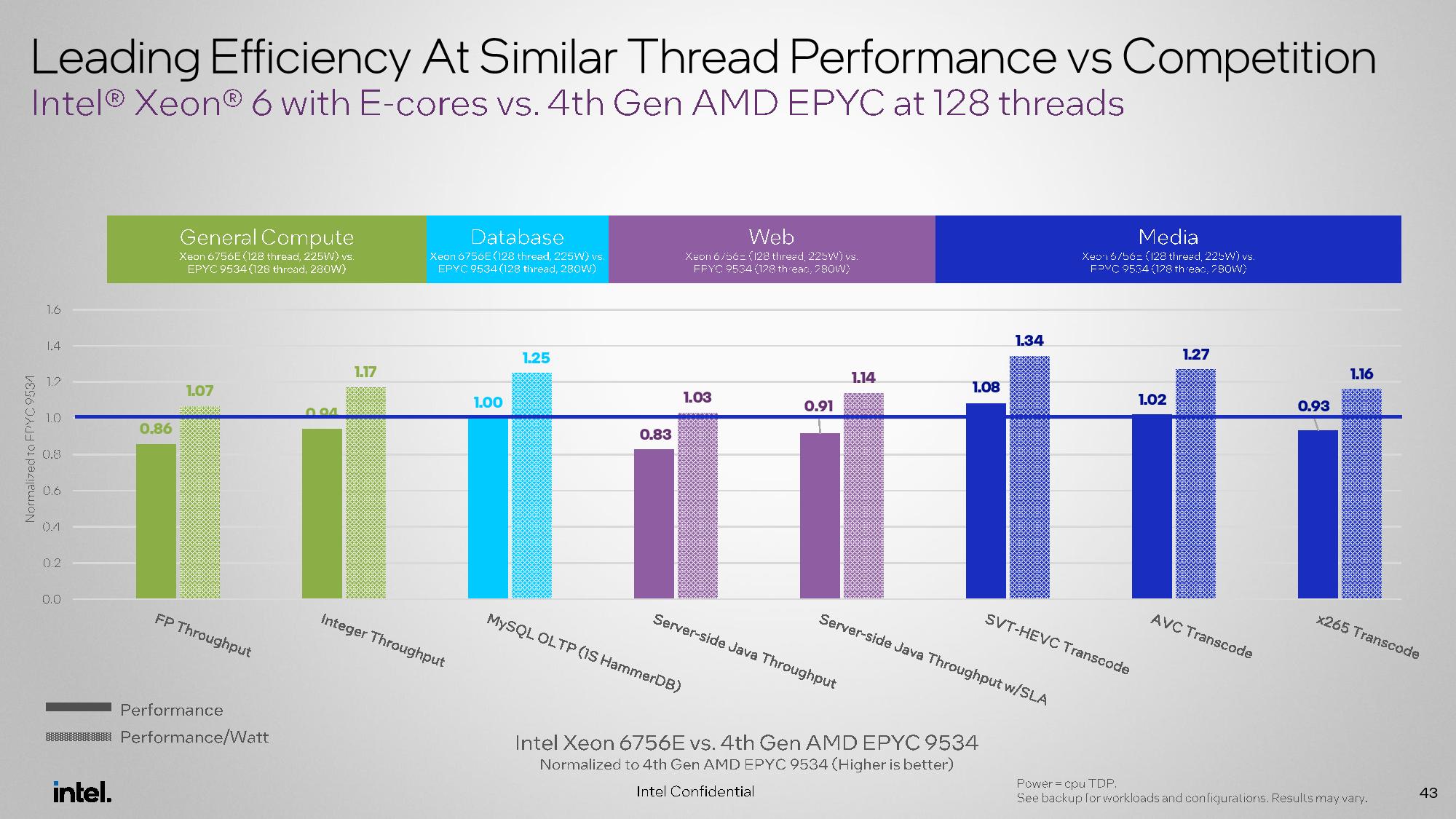
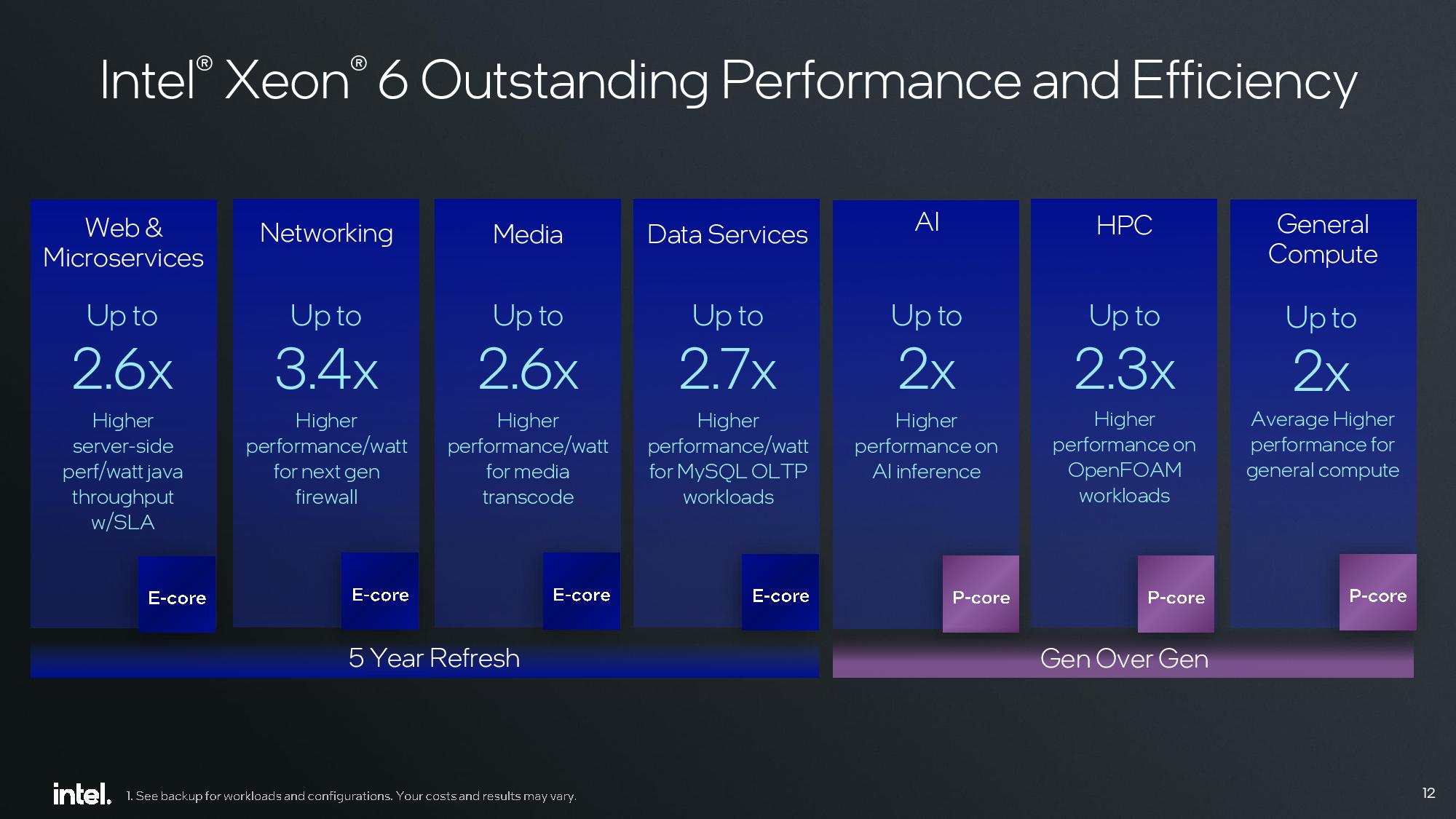






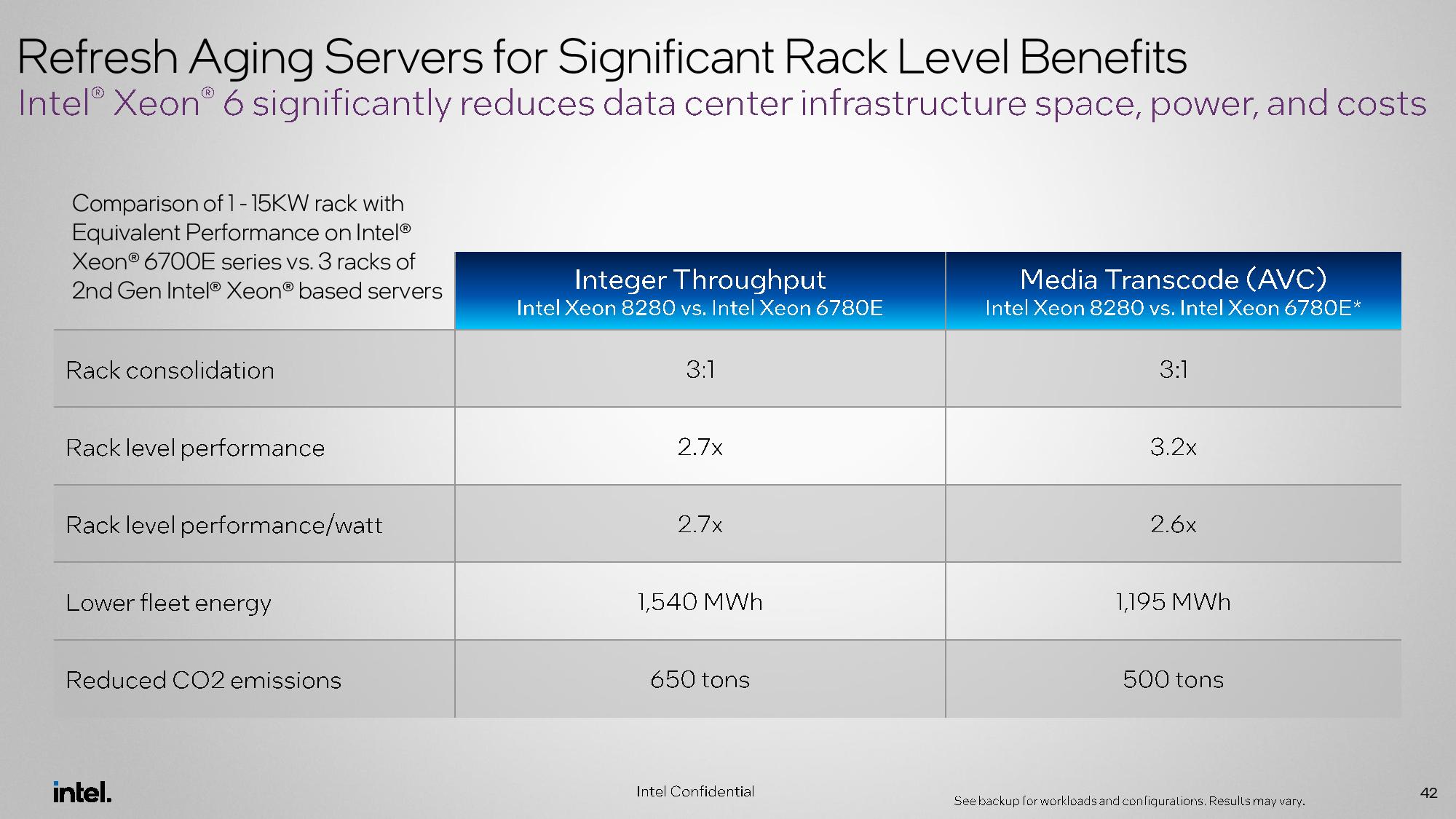


Despite using E-cores, Intel positions the 6700E models against AMD's P-core-powered EPYC processors. AMD's density-focused Bergamo platform comes with 12 memory channels, whereas the 6700E series supports eight memory channels to reduce cost. Intel shared a series of benchmarks to tout its performance advantages in several workloads, with many of the comparisons focusing on the generational performance improvements that can be expected by upgrading to newer models. As always, take vendor-provided benchmarks with some salt. Intel isn't shying away from third-party benchmarking — we have a server in our labs, so you can expect a full review with performance benchmarking soon.
Get Tom's Hardware's best news and in-depth reviews, straight to your inbox.
Intel's radical improvements in power consumption are a key focus point, so the company compared Xeon 6's power efficiency against AMD's EPYC across a wide range of general compute, database, web, and media workloads. Depending on the workload, Xeon 6's power efficiency advantages ranged from 7% to 34%. Intel also highlighted performance disclosures from its partners, including eBay's findings of a 25% performance-per-watt improvement for its use case against a competitive solution, which would, of course, imply an EPYC processor.
Other highlights of Intel's performance claims include up to a 2x improvement in AI, a 2.3x improvement in HPC, and up to twice the general compute performance for its users updating over the prior Fifth-Gen Xeons. Naturally, those deltas become much larger when compared to Intel's five-year-old second-gen models, but this is the typical upgrade cadence for most server gear. In media transcode workloads, Intel claims a 2.6x improvement in performance-per-watt and a 4.2x improvement in overall performance over second-gen Xeons.
Intel also touts strong rack consolidation opportunities, saying that the 6700E series offers a 3:1 ratio over second-gen Xeon. That translates to replacing 200 racks of second-gen Xeon with only 66 racks of the 6700E series.


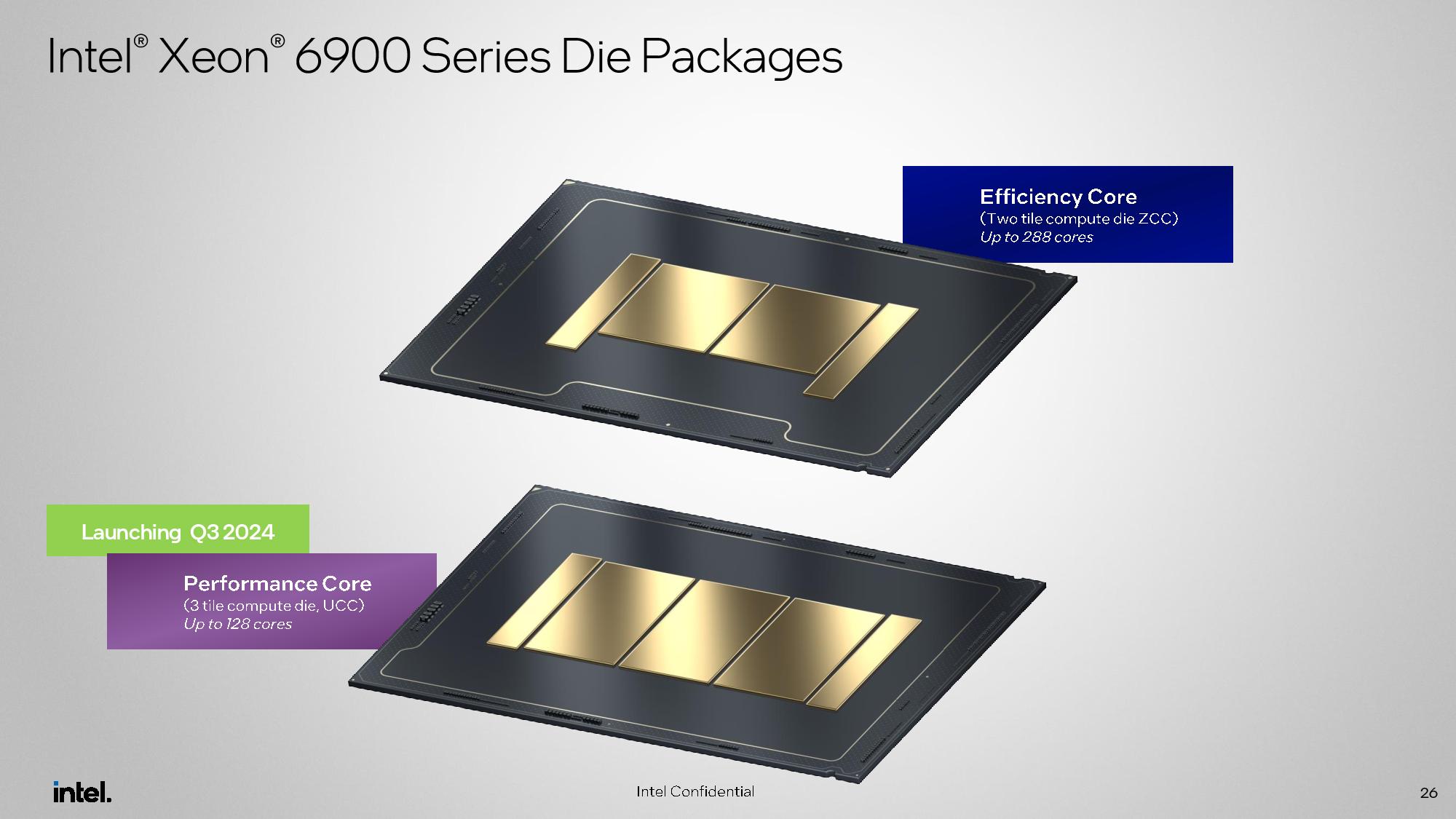



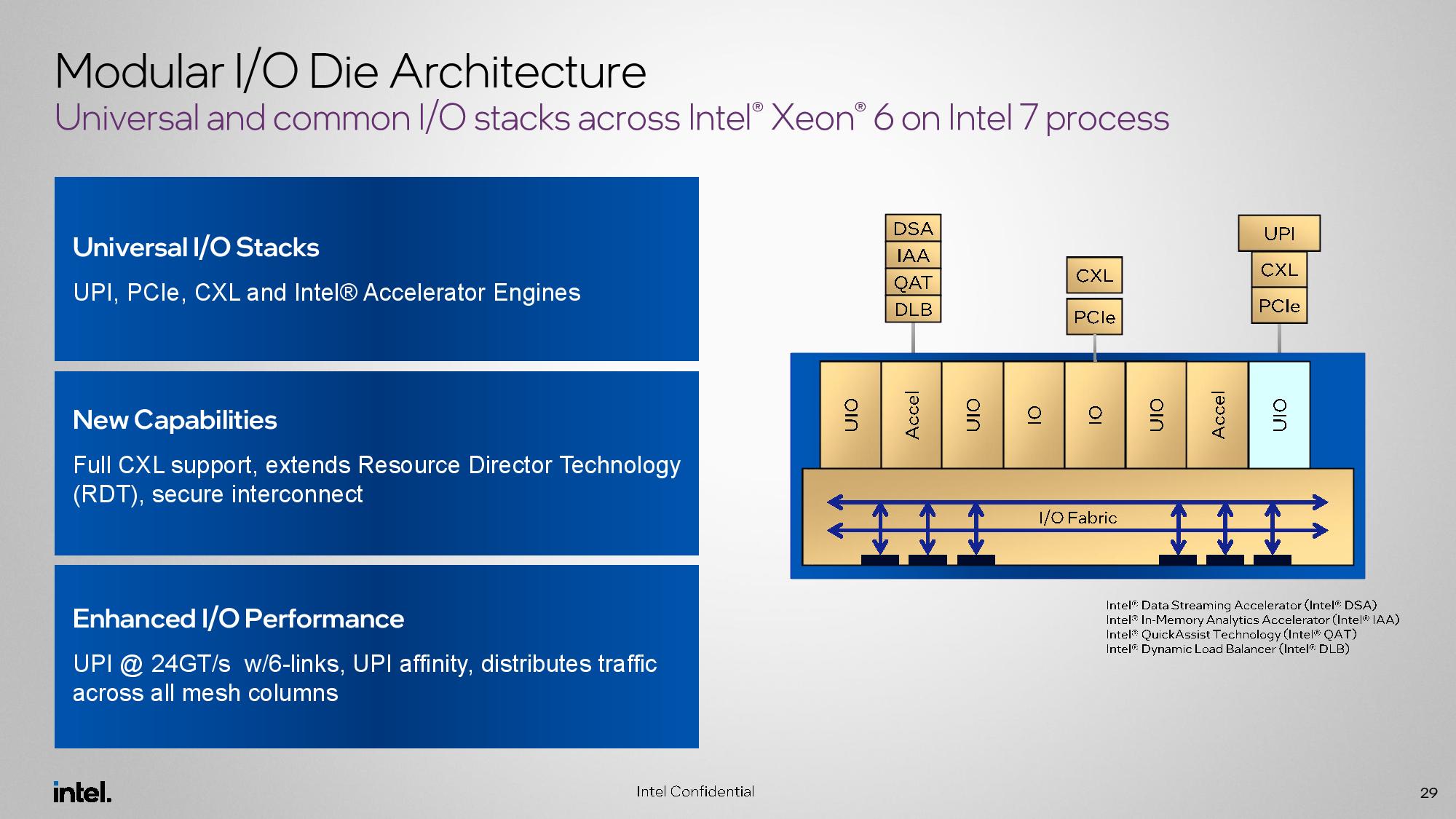






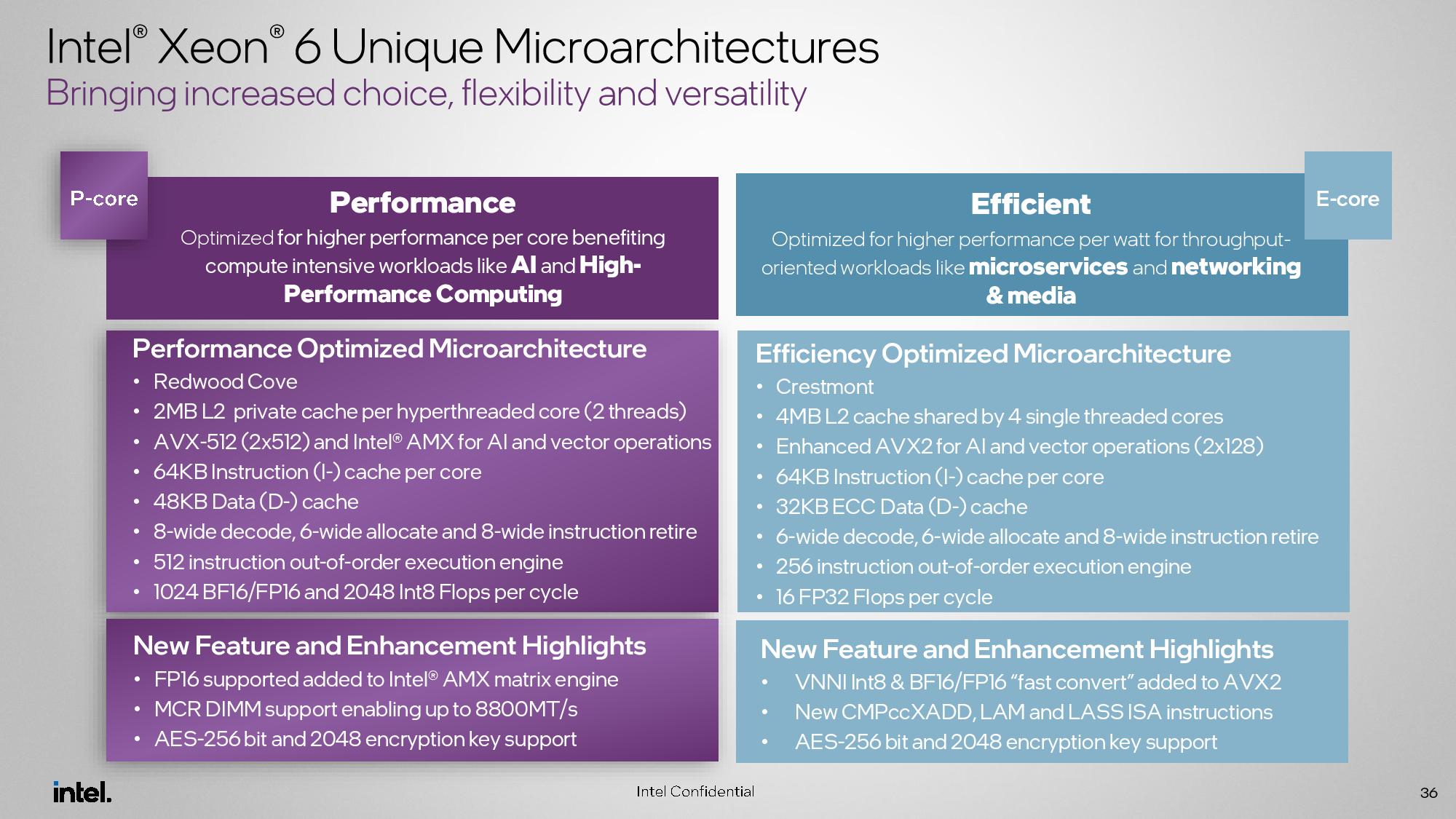



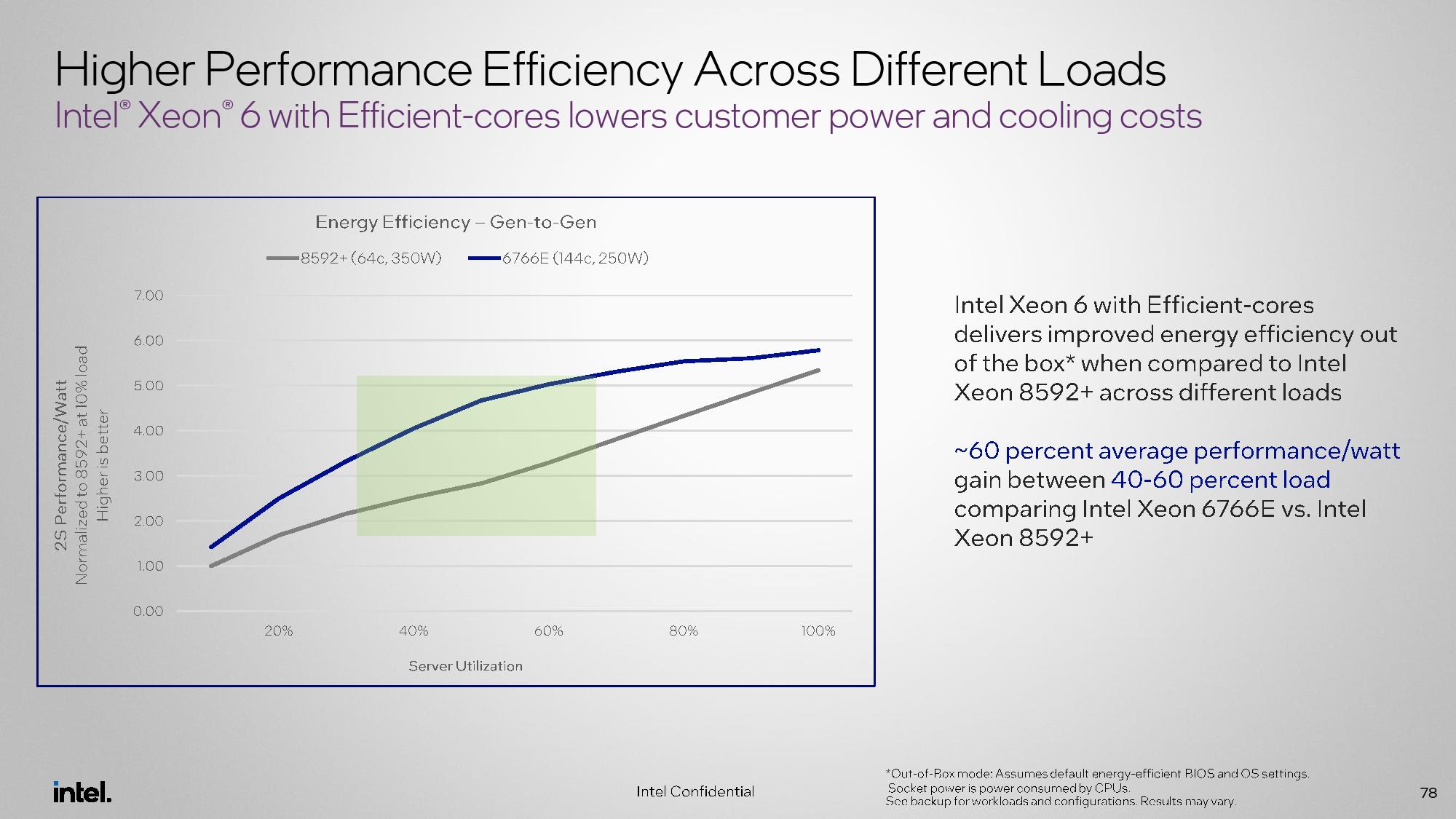


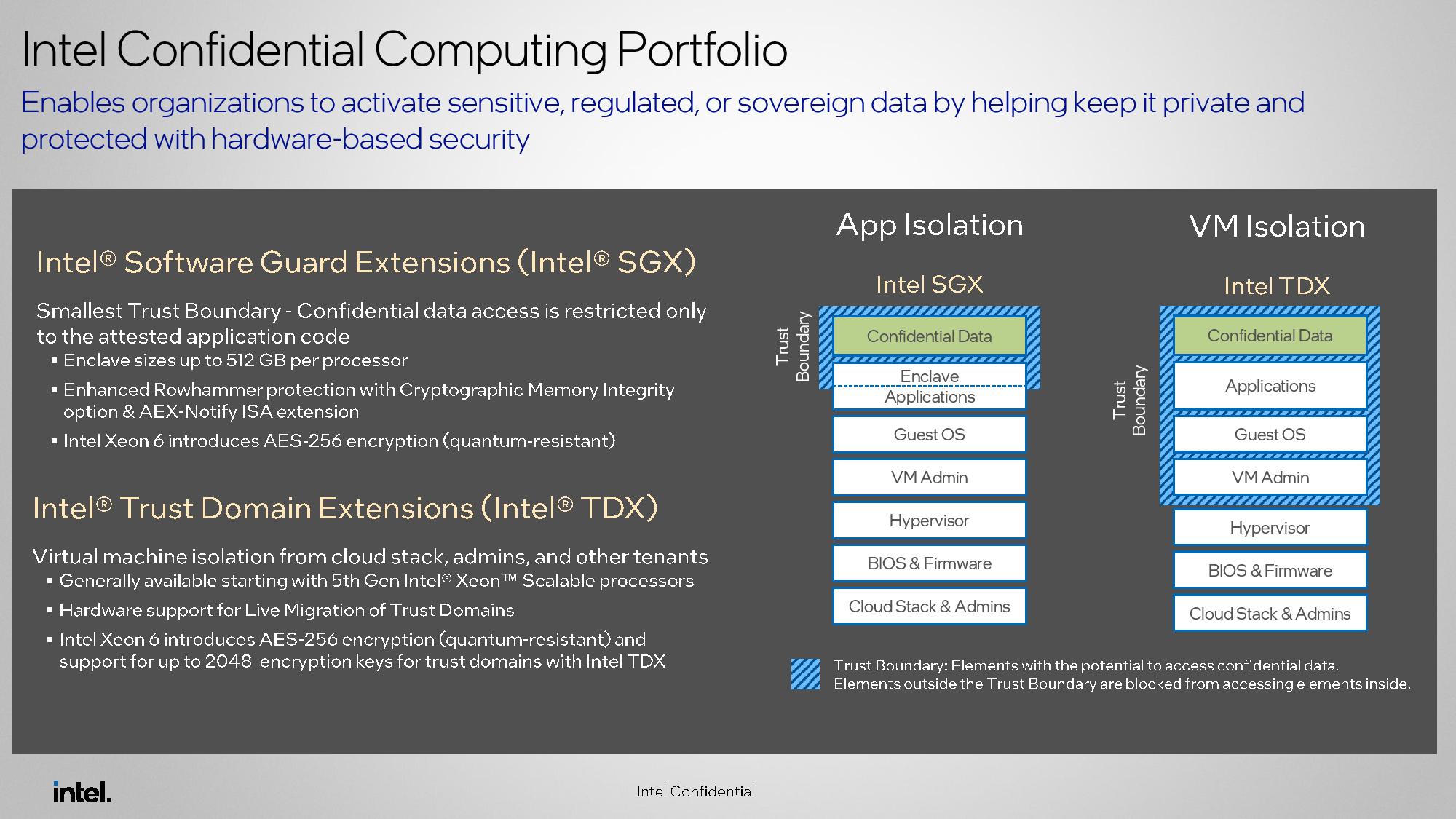


We've covered the Sierra Forrest architecture in depth here. The chips come in four different package types, two of which are designed for SP systems and the other two specifically for AP servers.
All models support DDR5-6400 in either eight- or 12-channel configurations, including MCR DIMM support for the P-core models, boosting throughput up to DDR5-8800. The chips also support either 88 or 136 PCIe 5.0 lanes, but this varies based on the number of sockets in the server. The standard SP servers support from 1S to 8S systems, while the AP platforms only scale to two sockets. Intel also offers full support for CXL 2.0, including support for Type 3 devices.
The E-core models launching today use the Crestmont architecture, while the P-core models leverage Redwood Cove. The chips are socket-compatible, but due to the differences between the core microarchitectures, the E-core models don't support AVX-512 or AMX. Intel also offers a full suite of security features and continues to offer its in-built QAT, DLB, DSA, and IAA accelerators.
Many of Intel's partners already have Xeon 6700E processors working in the field, but the company is now shipping to the broader market. We'll provide the full architectural breakdown and performance data in our upcoming review; stay tuned.

Paul Alcorn is the Editor-in-Chief for Tom's Hardware US. He also writes news and reviews on CPUs, storage, and enterprise hardware.
-
thestryker These high core count E-core based CPUs seem really good for cloud services especially for circumstances where they are already disabling SMT. With how well they seem to perform already it's going to be really interesting to see what Clearwater Forest ends up looking like (and whether or not Darkmont is much different than Skymont). STH has their initial Intel sponsored look done, but they did also get a retail sample to verify results with: https://www.servethehome.com/intel-xeon-6-6700e-sierra-forest-shatters-xeon-expectations/Reply
edit:
Phoronix testing with the Intel reference system:
https://www.phoronix.com/review/intel-xeon-6780e-6766e
removed fixed bits:
Some incorrect stuff noted from article:
The P-core Granite Rapids models, which can have up to 86 P-cores, will launch in Q3 of 2024.
This is the Q1 2025 6700P SKU series, the 128 P-core 6900P is the one launching in Q3 2024. -
peachpuff Those are some fancy graphs, kudos to the intel marketing team for trying really hard to sell these atom cores to the server market...Reply -
jeremyj_83 Reply
These aren't the atom cores of 10 years ago. These actually have about the same per clock performance as Broadwell CPUs.peachpuff said:Those are some fancy graphs, kudos to the intel marketing team for trying really hard to sell these atom cores to the server market... -
jp7189 Reply
..and still Intel marketing pulled out all the stops. Those charts compare their brand new 128 core chip against AMD's 2+ year old 64 core chip, and it barely wins on a few hand picked benchmarks. We'll have to wait for independent test before we know for sure, but it's looking like AMD is going to dominate on this gen...again.jeremyj_83 said:These aren't the atom cores of 10 years ago. These actually have about the same per clock performance as Broadwell CPUs. -
jeremyj_83 Reply
Servethehome already did a look at the new E core server.jp7189 said:..and still Intel marketing pulled out all the stops. Those charts compare their brand new 128 core chip against AMD's 2+ year old 64 core chip, and it barely wins on a few hand picked benchmarks. We'll have to wait for independent test before we know for sure, but it's looking like AMD is going to dominate on this gen...again. -
bit_user Eek! Whoever downsampled the "original" versions used nearest-neighbor sampling and a scaling ratio that makes some of the text virtually unreadable!Reply
Look at the headings in this chart. In some of them, you can barely make out the model number of the Xeon being used, because some the horizontal strokes are entirely skipped by the sampling!
-
bit_user After seeing the benchmarks on Phoronix, I think Sierra Forest effectively answered the threat from Bergamo (Zen 4c), but I doubt it's up to the challenge it's about to face from Zen 5c. At least the matchup shouldn't be as lopsided as when Sapphire Rapids went up against Genoa (Zen 4) and Bergamo.Reply
The real test is one we can't directly run - how well it compares against the latest crop of ARM cloud-based server CPUs, like Graviton 4. This set of benchmarks attempts to put a stake in the ground, by including a 128-core Ampere Altra CPU, which is now circling the drain of obsolescence. Even so, Altra manages to notch a couple wins on efficiency, and places quite well in some other efficiency rankings.
https://www.phoronix.com/review/intel-xeon-6700e-ampere-altra
Also, I should point out that the lowly EPYC 8534PN (Siena; small Zen 4c) scores 15% better on efficiency (i.e. Geomean vs. average power) than the best Sierra Forest entrant (Xeon 6766E). -
peachpuff Reply
Looks like cga color palette 😂bit_user said:Eek! Whoever downsampled the "original" versions used nearest-neighbor sampling and a scaling ratio that makes some of the text virtually unreadable!
Look at the headings in this chart. In some of them, you can barely make out the model number of the Xeon being used, because some the horizontal strokes are entirely skipped by the sampling!
-
bit_user Reply
Sorta, but I'd say more like EGA, because CGA can only do 4 colors. It does almost fit CGA's CMK palette, though.peachpuff said:Looks like cga color palette 😂
Note how it lacks any green?
Here's EGA, which was the first color monitor I had.
-
bit_user Reply
Not sure about that. First of all, hypervisors provide the option to avoid simultaneously scheduling two different VMs on the same physical core. As if that wasn't enough the Linux Kernel now has an option called "core scheduling", which does the same thing at the process level. This allows SMT to be restricted to cases that should already be "safe" (i.e. where paired threads are already in the same memory space). Google was the main contributor behind the "core scheduling" patch. If the Cloudy people were really so negative on SMT, then it'd be awfully surprising for Intel to have kept it in the server version of Lion Cove.thestryker said:cloud services especially for circumstances where they are already disabling SMT.
Nice!thestryker said:STH has their initial Intel sponsored look done, but they did also get a retail sample to verify results with